#urban biodiversity
Text
By Patrick Barkham
The Guardian
May 27, 2023
York groundsel was a cheerful yellow flower that slipped into global extinction in 1991, thanks to overzealous application of weedkiller in the city of its name.
But now the urban plant has been bought back to life in the first ever de-extinction in Britain, and is flowering again in York.
The species of groundsel was only ever found around the city and only evolved into its own species in the past century after non-native Oxford ragwort hybridised with native groundsel.
York groundsel, Senecio eboracensis, was discovered growing in the car park of York railway station in 1979 and was the first new species to have evolved in Britain for 50 years, thriving on railway sidings and derelict land.
But the new plant’s success was short-lived, as urban land was tidied up and chemicals applied to remove flowers dismissed as “weeds”.
It was last seen in the wild in 1991. Fortunately, researchers kept three small plants in pots on a windowsill in the University of York. These short-lived annual plants soon died, but they produced a precarious pinch of seed, which was lodged at Kew’s Millennium Seed Bank.
Andrew Shaw of the Rare British Plants Nursery had a vision to bring the species back to life, but when tests were carried out on some privately held seeds very few germinated successfully.
So Natural England, the government’s conservation watchdog, quickly authorised a de-extinction attempt via its species recovery programme, which has funded the revival of the most threatened native species for 30 years.
“The Millennium Seed Bank said the seed was getting near the end of its lifespan and so we thought we would only have one more chance of resurrecting it,” said Alex Prendergast, a vascular plant senior specialist for Natural England.
Natural England paid for a polytunnel at the Rare British Plants Nursery in Wales, where 100 of the tiny seeds were planted. To the botanists’ surprise, 98 of the seeds germinated successfully. The polytunnel rapidly filled with a thousand York groundsel plants.
In February six grams of seed – potentially thousands of plants – were sown into special plots around York on council and Network Rail land.
This week, the first plants in the wild for 32 years began to flower, bringing colour to the streets and railway sidings of York.
This de-extinction is likely to be a one-off in this country because York groundsel is the only globally extinct British plant that still persists in seed form and so could be revived.
But Prendergast said the de-extinction showed the value of the Millennium Seed Bank – to which plenty of York groundsel seed has now been returned – and there were a number of good reasons for bringing the species back to life.
“It’s a smiley, happy-looking yellow daisy and it’s a species that we’ve got international responsibility for,” he said.
“It only lives in York, and it only ever lived in York. It’s a good tool to talk to people about the importance of urban biodiversity and I hope it will capture people’s imagination.
“It’s also got an important value as a pollinator and nectar plant in the area because it flowers almost every month of the year.”
11K notes
·
View notes
Text
Good afternoon everyone~
It's cold, windy and it's been raining on and off all day but I finally got out to harvesting the sweet potatoes.
I started with the 'L' bed.

This is the bowl I'll be using to collect the spuds for this deep raised bed.
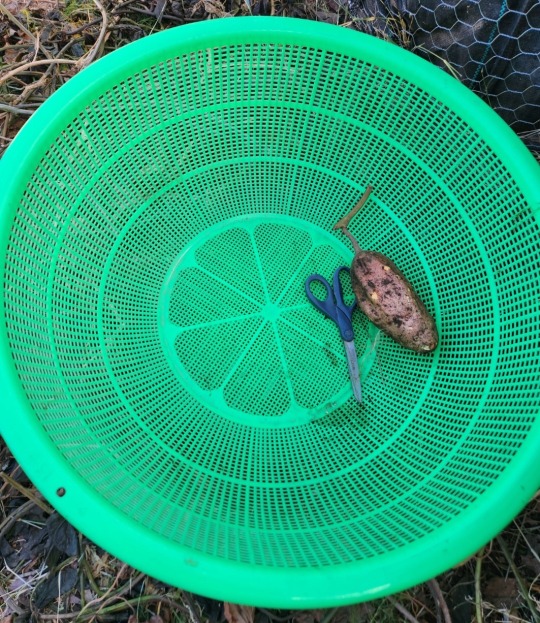
Those are full size scissors btw. This is the absolute biggest strainer I own and when I do harvesting I'm always glad to have it! Helps with carrying and washing off dirt outside so much easier!

It was pretty fun digging round for the spuds and to be honest the size and shape of some of them really suprised me!

For some size comparison, my hand is right on top of them.
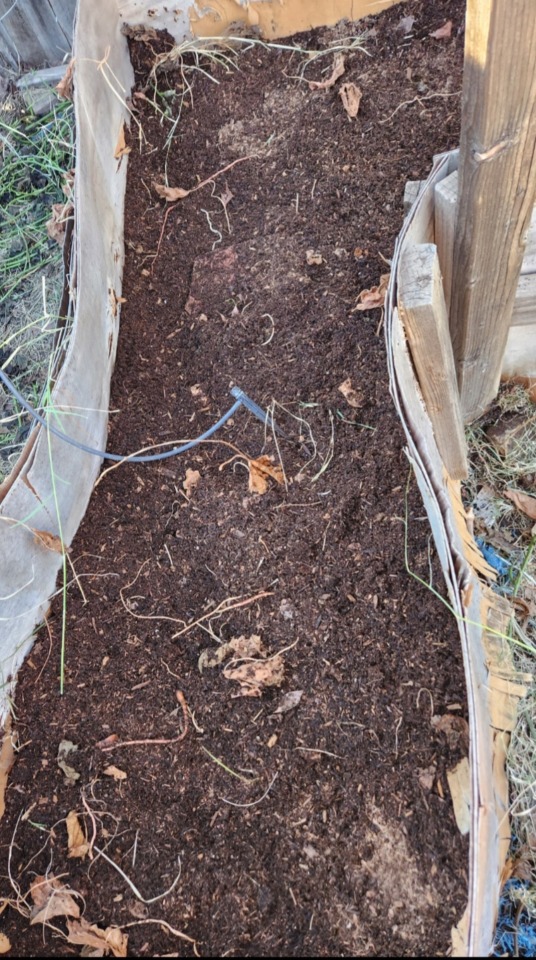
All cleaned out!
Next was the little round bed in the corner. I wasn't really expecting much, but it filled the bin pretty good.

I've washed the spuds off and am letting them dry off but I'll be finding a spot inside soemwhere to let them sit and cure for a bit of time. (I probably will let them cure until end of febuary.)
Curing your sweet potatoes is what makes them sweet, you can eat them right away but their said to be bitter. (I will be trying 1 potato to see if this is true!) Curing them should be done for at least 2 week in a cool dry space (around 80*f). If you under 80*f space add 7 more days.
I thought this was neat and wanted to share it. since I've not seen a sweet potato grown or dug up before

I wasn't expecting so much differance in spud size from one single root.
And one last pic,
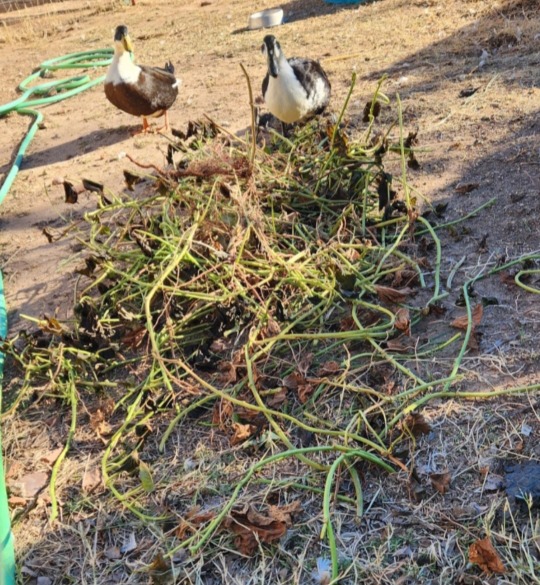
The ducks quite like the greens, while there's not much left of it I'm going to leave the vines a couple days so they can use it as enrichment/snack opportunity.
Weigh in on the spuds later!
🍠🌱Happy Homesteading and Harvesting!!
🌱🍠
1.11.2024
#self sufficient living#homesteading#thestudentfarmer#studentfarmer#self sufficiency#food#garden#gardening#low waste#duck#sustainability#smalls scale differences#urban animal keeping#urban biodiversity#urban homesteading#urban gardening#urban farming#grow what you can#simple plants to grow#multipurpose crops#right to grow#human right to clean food#right to grow food#raised garden beds#start to finish#will it grow?#food sovereignty#whole foods#first time growing#going green as can be
59 notes
·
View notes
Text
67 notes
·
View notes
Text
Why do some bird species seem to flourish alongside humans, eating our crumbs and nesting in our backyards, while others prefer to live as far as possible from dense human populations?
Researcher Monte Neate-Clegg first began to ponder that question while attending the American Ornithological Society’s 2019 conference in Anchorage, Alaska. “I was staying at an Airbnb, and two of the birds I wanted to see in Anchorage, white-winged crossbills and boreal chickadees, were just in the yard,” says Neate-Clegg, then a Ph.D. student at the University of Utah. Although new and beautiful to him, the species are common in Anchorage — so omnipresent they’re typically ignored by residents.
“I started thinking, what is it that makes these ‘trash birds’ here, and not elsewhere?”
Neate-Clegg sounds sheepish about using the pejorative-sounding term “trash bird,” but it’s a phrase commonly used by birdwatchers to refer to species so ubiquitous at a given location that they cease to become interesting and, in fact, can become downright irritating. Classic examples include pigeons in city centers and snack-stealing gulls on beaches.
But one man’s trash bird is another’s research query. Neate-Clegg wondered if specific traits make certain species more able to thrive in cities around the world. And after joining ornithologist Morgan Tingley’s lab at UCLA as a postdoctoral researcher in 2021, he proposed a lab-wide project to try to answer his question.
Their research drew on big data to provide some clues — and may even reveal a roadmap for making our cities more bird-friendly.
...
Ultimately the members of the Tingley lab examined traits underlying the urban tolerance for 3,768 bird species in 137 cities. They found that urban-tolerant birds tend to be smaller, less territorial, longer-lived, and less picky about their diets and habitats than other species. They also have greater dispersal ability — they move more easily from one place to another — and lay larger clutches of eggs.
2 notes
·
View notes
Text
"With “green corridors” that mimic the natural forest, the Colombian city is driving down temperatures — and could become five degrees cooler over the next few decades.
In the face of a rapidly heating planet, the City of Eternal Spring — nicknamed so thanks to its year-round temperate climate — has found a way to keep its cool.
Previously, Medellín had undergone years of rapid urban expansion, which led to a severe urban heat island effect — raising temperatures in the city to significantly higher than in the surrounding suburban and rural areas. Roads and other concrete infrastructure absorb and maintain the sun’s heat for much longer than green infrastructure.
“Medellín grew at the expense of green spaces and vegetation,” says Pilar Vargas, a forest engineer working for City Hall. “We built and built and built. There wasn’t a lot of thought about the impact on the climate. It became obvious that had to change.”
Efforts began in 2016 under Medellín’s then mayor, Federico Gutiérrez (who, after completing one term in 2019, was re-elected at the end of 2023). The city launched a new approach to its urban development — one that focused on people and plants.
The $16.3 million initiative led to the creation of 30 Green Corridors along the city’s roads and waterways, improving or producing more than 70 hectares of green space, which includes 20 kilometers of shaded routes with cycle lanes and pedestrian paths.
These plant and tree-filled spaces — which connect all sorts of green areas such as the curb strips, squares, parks, vertical gardens, sidewalks, and even some of the seven hills that surround the city — produce fresh, cooling air in the face of urban heat. The corridors are also designed to mimic a natural forest with levels of low, medium and high plants, including native and tropical plants, bamboo grasses and palm trees.
Heat-trapping infrastructure like metro stations and bridges has also been greened as part of the project and government buildings have been adorned with green roofs and vertical gardens to beat the heat. The first of those was installed at Medellín’s City Hall, where nearly 100,000 plants and 12 species span the 1,810 square meter surface.
“It’s like urban acupuncture,” says Paula Zapata, advisor for Medellín at C40 Cities, a global network of about 100 of the world’s leading mayors. “The city is making these small interventions that together act to make a big impact.”
At the launch of the project, 120,000 individual plants and 12,500 trees were added to roads and parks across the city. By 2021, the figure had reached 2.5 million plants and 880,000 trees. Each has been carefully chosen to maximize their impact.
“The technical team thought a lot about the species used. They selected endemic ones that have a functional use,” explains Zapata.
The 72 species of plants and trees selected provide food for wildlife, help biodiversity to spread and fight air pollution. A study, for example, identified Mangifera indica as the best among six plant species found in Medellín at absorbing PM2.5 pollution — particulate matter that can cause asthma, bronchitis and heart disease — and surviving in polluted areas due to its “biochemical and biological mechanisms.”
And the urban planting continues to this day.
The groundwork is carried out by 150 citizen-gardeners like Pineda, who come from disadvantaged and minority backgrounds, with the support of 15 specialized forest engineers. Pineda is now the leader of a team of seven other gardeners who attend to corridors all across the city, shifting depending on the current priorities...
“I’m completely in favor of the corridors,” says [Victoria Perez, another citizen-gardener], who grew up in a poor suburb in the city of 2.5 million people. “It really improves the quality of life here.”
Wilmar Jesus, a 48-year-old Afro-Colombian farmer on his first day of the job, is pleased about the project’s possibilities for his own future. “I want to learn more and become better,” he says. “This gives me the opportunity to advance myself.”
The project’s wider impacts are like a breath of fresh air. Medellín’s temperatures fell by 2°C in the first three years of the program, and officials expect a further decrease of 4 to 5C over the next few decades, even taking into account climate change. In turn, City Hall says this will minimize the need for energy-intensive air conditioning...
In addition, the project has had a significant impact on air pollution. Between 2016 and 2019, the level of PM2.5 fell significantly, and in turn the city’s morbidity rate from acute respiratory infections decreased from 159.8 to 95.3 per 1,000 people [Note: That means the city's rate of people getting sick with lung/throat/respiratory infections.]
There’s also been a 34.6 percent rise in cycling in the city, likely due to the new bike paths built for the project, and biodiversity studies show that wildlife is coming back — one sample of five Green Corridors identified 30 different species of butterfly.
Other cities are already taking note. Bogotá and Barranquilla have adopted similar plans, among other Colombian cities, and last year São Paulo, Brazil, the largest city in South America, began expanding its corridors after launching them in 2022.
“For sure, Green Corridors could work in many other places,” says Zapata."
-via Reasons to Be Cheerful, March 4, 2024
#colombia#brazil#urban#urban landscape#urban planning#cities#civil engineering#green architecture#green spaces#urban heat#urban heat island effect#weather#meteorology#global warming#climate change#climate hope#climate optimism#climate emergency#climate action#environment#environmental news#city architecture#bicycling#native plants#biodiversity#good news#hope#solarpunk#ecopunk#hopepunk
12K notes
·
View notes
Text
#Urban Bird Ecology#Birds in Urban Environments#Urban Wildlife#Bird Adaptation#Urban Ecology Research#Urban Biodiversity#Wildlife Behavior#Urban Nature Exploration
1 note
·
View note
Text
Editor. Editora.
Word of the week. Palabra de la semana.

Hattie
Source / Fuente: Personal archive
#phd lifestyle#caturday#catslover#urban biodiversity#urban fauna#coworkers#editor#editora#writing#escritos#textos#handwriting#Hattie
0 notes
Text

Old school simplicity with new school flava.
#visionarygrowingsolutions#atlanta urban ag#compost#simple food small farmz#biodynamic#soil#biodiversity#soil biology#permaculture#urban ag#simplefoodsmallfarmz#simple food small farmz air bnb agriculture experience#small farmz simple food#simple food#simple things#soil fertility#soil food web#soil biodiversity#soil creation#atlanta airbnd experience#air bnb experience atlanta#atlanta air bnb urban agriculture experence#airbnb experience#maurice small
32 notes
·
View notes
Text
Here is an AMAZING piece on Solarpunk, it's abilities, and how it applies to our world written by Dr. Spencer Scott. I got to meet Spencer and his husband at their farm Solarpunk Farms in January of this year, and that experience is still something I hold super close to my heart. Highly recommend this reading, as well as everything else he's written, 10/10. You don't have to subscribe to solarpunk to enjoy it!
73 notes
·
View notes
Text
heres your reminder that there are whole ecossystems in cities. theres microbes and fungi and plants and animals. and they form their own biological community and its all around us. and we often just brush them off as pests or lesser for not being the beings that we see in the wild, but theyre there! theyre thriving and fighting and building their own peculiar urban ecossystem. and how could you say they dont matter just because theyre not in the wild?
cities arent dead. theres life everywhere. theres life in the spiders and insects and birds. theres life in the mold and moss and flowers and trees. just look around you! nature is here! nature is alive!
21 notes
·
View notes
Text

Kolam ikan
#invertefest#art#digital art#illustration#insect#biodiversity#urban nature#pond#indonesian artist#artistofsea
389 notes
·
View notes
Text
#good news#environmentalism#science#nature#environment#animals#australia#urban animals#urban life#biodiversity#conservation#bugs#spiders#fungi#plants#ecology
50 notes
·
View notes
Text
Hello and Welcome to the garden!
Today I have a bit of a smallish and short post~
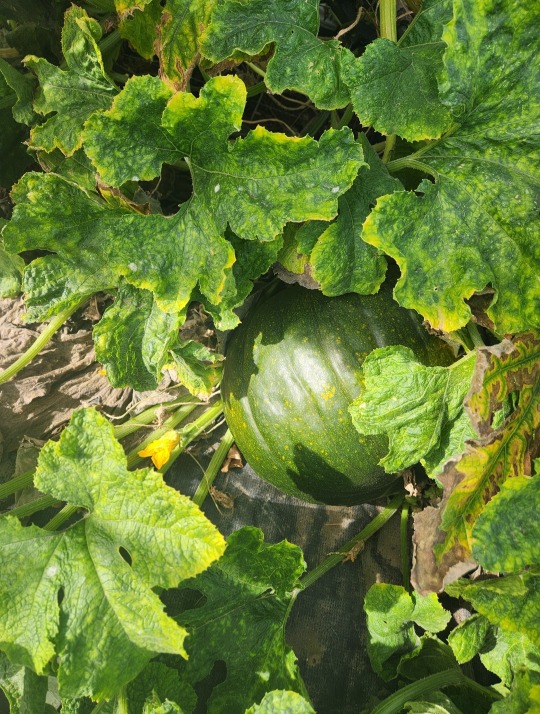
The pumpkin is developing pretty good, the one on the trellis is a little smaller than this one. I'm starting to see new flowers on the vine, but I think I'll be picking them to use for stir fry/fried rice varient, ommlettes, or salad.

The first planting of the velour beans is starting to get what I think might be the end of their cycle, a few more flowers arrived but the plants aren't really b taking off to much in growth or producing. If I recall right I got around 48 oz of beans. (Their being crowded out by the sunflowers now.)
I'm gonna leave them in and jsut see how long/well they do.

Starting at the far left, sunflowers+ velour beans and pumpkin
2nd in from left. Starting closest to us. The broccoli and nasturtium. I'm gonna pick some of the broccoli leaves this week for pan fried veggies. Broccoli leaf+rice (not sure if blanching, pan fry w/garlic+butter or a cheese/broc soup.)
3rd row from left starting closest. The eggplants, who have some flowers but I've not seen any eggplant yet. Cabbages (2), they've got little heads coming in. I have not yet sprayed down with the tea but I haven't seen much more pest issue. And last the cucumbers. One is pretty much done, the other has teeny lil cucumbers coming in, but I don't expect too much more growth from them. If they do I may just let it go to seed and see if it does better next year in a different spot.
Edit to add, I forgot the last row!
4th row from left, second planting of velour beans, with the surviving cabbages and carrots. I picked a few of the carrots this morning

Close up of the dying/dead and the hanging in there cucumbers.
Finally got down to the hardware store. We got wood, pipes for extending the garden fence, dirt and some time.

We got 2 boxes made up. So next step is to get the fence panels made up to extend the garden space and protect it from the stray/feral cats.
I got peppers, tomatoes seed started this week, though im hoping I didn't lose a tray of peppers due to a watering malfunction. (Always check your seedlings daily!) I also got some garlic in the ground and some ginger root too.
Thats it for my update for now :)
🌱🌻Happy Homesteading and gardening! 🌻🌱
12 18 2023
#homesteading#self sufficient living#thestudentfarmer#studentfarmer#self sufficiency#food#garden#gardening#repurposed#food is a human right#right to grow#food rights#urban homesteading#urban gardening#urban farming#urban biodiversity#right to clean food#human right to clean food#smalls scale differences#small scale farming#raised garden beds#gardens not yards#root to tip cooking#rooter to tooter cooking#low waste#closed loop#use it all#food frugality#preservation of food#sustainable efforts
24 notes
·
View notes
Video
https://homegrownnationalpark.org/
start showing up to your local city and county planning and zoning meetings and demand this. HOA meetings too.
#tiktok#biodiversity#home grown national park#urban design#urban planning#Ecosystem#gardening#community garden#garden#DIY gardening#nature
108 notes
·
View notes
Text
Last summer I took advantage of my break from teaching by enjoying long, daily walks around my neighborhood. I indulged my mind and body in the blueness, stillness, and leafiness that is North Carolina in June and July. It’s truly astounding how many leaves a willow oak can cram into one tiny piece of sky.
On my walks, the yard of one house stuck out. It was unlike any yard I’ve seen around my city or in any of the other cities in the United States, Canada, and Australia where I’ve lived. It is a forest yard. Nearly a dozen large trees are interspersed amid a dense stand of saplings and shrubs. That summer, leaf litter covered the ground. The top of the house was only visible if I craned my neck to see down the paved driveway, itself narrowing and crumbling as roots, lichens, and fungi worked their inexorable magic.
Depending on your perspective, the house with the forest yard could be seen either as an eyesore — and the scariest place to trick-or-treat — or, as in my case, the most splendid place imaginable.
At this point, I should probably mention that I’m an urban ecologist and that the forest yard makes my heart flutter at the possibility and hope of nature in cities.
I looked at aerial images for the area, and they revealed that the trees around that home, which haven’t been actively “managed,” are about 50 years old. Over that time the forest yard has accumulated a bewildering array of species and ecological interactions. Its tulip poplars, walnuts, cedars, redbuds, pines, and willow oaks have soaked up the atmosphere’s carbon dioxide and turned it into much-needed habitat for wildlife: butterflies, bees, and other insects; lizards, snakes, and turtles; frogs and toads; birds; and mammals. It’s home to a multitude of soil invertebrates and fungi that keep the business side of an ecosystem — aka decomposition — going. All the species that share this shady third-of-an-acre lot are intertwined in a complex tangle of relationships that keeps them fed and feeding on one another, interdependent to varying degrees for their life and livelihood.
And all of this exists amidst a matrix of roads, single-family and multiplex housing, commercial plazas, light industry, and high rises that make up a medium-sized city in the Southeast. The forest yard is a little island of nature in a nearly lifeless sea of concrete, asphalt and lawn.
But, to my inexhaustible surprise, that sea of concrete, asphalt, and lawn is not as empty as we tend to assume. Very far from it. Places of dense human habitation are also where many species reside, including some that are threatened. A recent analysis of the birds and plants that occur in 147 cities across the globe revealed that the sampled cities were home to 2,041 bird species — about one-fifth of Earth’s total avian diversity — and 14,240 plant species. These include 36 bird and 65 plant species threatened with global extinction.
0 notes
Text
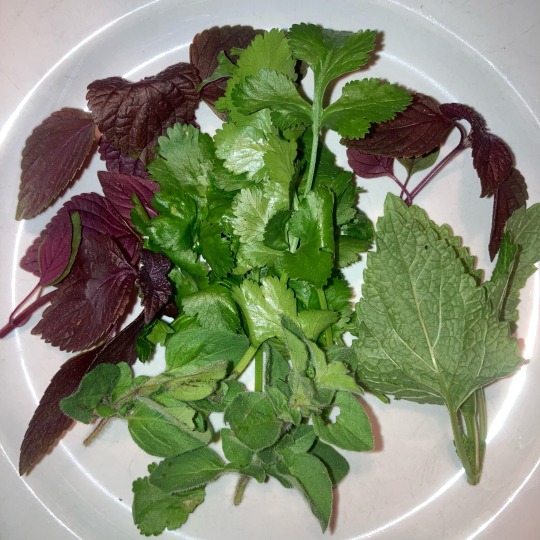
Self seeding and perennial herbs get the job done. Oregano, purple shiso, lemon balm and cilantro.
#herbs#perennial herbs#self seeding herbs#oregano#shiso#cilantro#lemon balm#atlanta#atlanta airbnd experience#air bnb experience#atlanta urban ag#compost#soil health#soil creation#biodiversity biodynamics#permaculture#polycultures#food systems#food access#soil food web#organic#food justice#food sovereignty#vermicomposting#food security#maurice small
73 notes
·
View notes